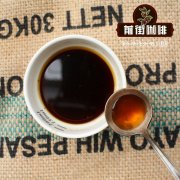What is a premium Arabica coffee bean?| How's the Arabica coffee? How's the flavor?

Professional coffee knowledge exchange More coffee bean information Please pay attention to coffee workshop (Weixin Official Accounts cafe_style)
The three native species are arabica, robusta and liberica. Arabica production ranks first, accounting for about 60 - 70% of the world's coffee production. There are Bourbon, Tibica and other sub-varieties. Robusta accounts for about 30 - 40% of the world's coffee production. Liberica accounts for only 3% of the total and is grown mostly in the Asia-Pacific region.
Liberia, also known as large coffee beans, has strong vitality, but at the same time its flavor and leaf rust resistance are weak. With less than 1% planted, it has basically withdrawn from the commercial market and is only preserved in scientific research. So today we're going to focus on Arabica.
of Arabica
Also known as Arabica coffee beans, it originated in Ethiopia. Arabica coffee trees grow more at altitudes of 1000-2000 meters; more cold-resistant, suitable growth temperature of 15-24℃; need greater humidity, annual rainfall of not less than 1500 ml, at the same time, there are higher requirements for cultivation techniques. Arabica coffee tree is a large shrub, leaves are oval, dark green, fruit is also oval, generally two slightly flat beans, obverse was long oval, narrow and curved crack in the middle, S-shaped, beans on the back of the arc shape is more flat. Caffeine content is about 0.8%-1.5%.
Arabica coffee's excellent flavor and aroma make it the only coffee of these native species that can be drunk directly and alone, such as Jamaica Blue Mountain, Indonesian Mandrine, Yerba Coffee and Brazilian Coffee. However, its resistance to drought, frost, diseases and insect pests is weak, especially leaf rust, the biggest natural enemy of coffee, so all producing countries are committed to improving varieties.
Because latitude and longitude affect temperature, rainfall, light conditions, sun exposure, etc., many decisive factors for coffee bean flavor, people found that the most suitable area for coffee cultivation is between the Tropic of Cancer, which is also known as the coffee gold cultivation belt. Differences in growing conditions also make the essential difference between arabica beans and robusta beans.
Arabica coffee produced in different regions, different altitudes and different climates has its own characteristics and can show completely different personality flavors. When unroasted, it smells like grass. When properly roasted, it shows "fruity"(medium light roast) and "caramel flavor"(deep roast). Suitable for single origin and various blends. It can be prepared by various extraction techniques.
Arabica Flavor
Almost all of the fine coffees we see in cafes are Arabica beans, such as Yega Shefi, Sidamo and the summer roses that have been in the limelight in recent years. Because Arabica beans retain the flavor of coffee producing areas to the greatest extent, such as peach, cocoa, jasmine and so on can be tasted from high-quality coffee flavor.
Deep coffee lovers can taste the unique flavors from different coffee producing areas from fine coffee.
Latin American coffee beans, cocoa and nut flavor is the most prominent, such as: Brazil, Colombia, etc.;
Asia-Pacific coffee beans contain earthy and herbal mellow aroma, such as Vietnam, China, Sumatra, etc.;
African coffee beans with a variety of tropical fruit flavor, slightly higher acidity, such as Ethiopia, Kenya and so on
END
Important Notice :
前街咖啡 FrontStreet Coffee has moved to new addredd:
FrontStreet Coffee Address: 315,Donghua East Road,GuangZhou
Tel:020 38364473
- Prev

How is the quality of Yunnan small-grain coffee in China? how can Yunnan small-grain coffee taste good?
Professional coffee knowledge exchange more coffee bean information please follow the coffee workshop (Wechat official account cafe_style) Yunnan coffee planting area and output account for more than 99% of the country. The natural conditions of Yunnan are very similar to those of Colombia, the taste of the coffee produced in Yunnan is similar to that of Colombian small-grain coffee, and the overall quality of Yunnan coffee is better than that of Brazilian coffee. Liang Houfu, a famous news critic in the United States, wrote: the world
- Next

Is drinking black coffee useful to lose weight? can drinking black coffee in the morning have the effect of losing weight?
Professional Coffee knowledge Exchange more information on coffee beans Please follow the coffee workshop (Wechat official account cafe_style) American coffee, whose name comes from the war, was born after World War II. When the Americans ended their war with Europe, a lot of troops came to southern Europe, but they couldn't drink espresso, so they chose to open it warm.
Related
- Beginners will see the "Coffee pull flower" guide!
- What is the difference between ice blog purified milk and ordinary milk coffee?
- Why is the Philippines the largest producer of crops in Liberia?
- For coffee extraction, should the fine powder be retained?
- How does extracted espresso fill pressed powder? How much strength does it take to press the powder?
- How to make jasmine cold extract coffee? Is the jasmine + latte good?
- Will this little toy really make the coffee taste better? How does Lily Drip affect coffee extraction?
- Will the action of slapping the filter cup also affect coffee extraction?
- What's the difference between powder-to-water ratio and powder-to-liquid ratio?
- What is the Ethiopian local species? What does it have to do with Heirloom native species?

